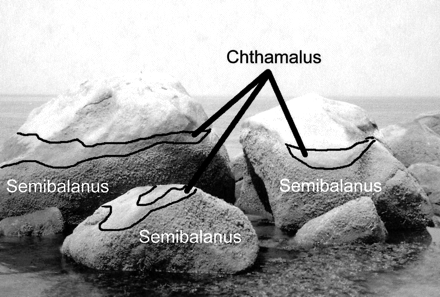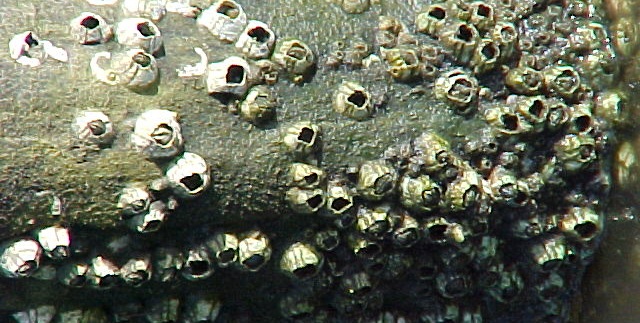Interactions
As for most organisms, competition
is a great part of their lives. This is a negative interaction
for both species as they must fight and use energy for precious
food and natural resources.
Chthamalus fragilis is
not free of competition either. Their main competitor -
Semibalanus balanoides
- can outcompete
Chthamalus fragilis for resources such as food, so this
affects the location of C.
fragilis. They take refuge from their better in the high
intertidal zones. Here it is too hot for
S. balanoides (Wethey
2002). Thus, here they are relatively free from competition. In
an experiment, transplants of
C. fragilis 80 km past
the northern limit of S.
balanoides survived up to eight years without the
competition otherwise present (Wethey 2002).
too hot for
S. balanoides (Wethey
2002). Thus, here they are relatively free from competition. In
an experiment, transplants of
C. fragilis 80 km past
the northern limit of S.
balanoides survived up to eight years without the
competition otherwise present (Wethey 2002).
Another big part of
Chthamalus fragilis’s life, which is commonly overlooked, is the
interaction of the barnacle and the surfaces to which it sticks. In
order to stick, the barnacle uses a special glue that is both
extremely strong and can be adhesive under water. Researchers at the
Okayama University's Marine Biotechnology Institute in Japan have
revealed the salt in ocean water triggers the adhesive properties of
C. fragilis and other
barnacles’ glue (Gill 2007). The glue is made of peptide bonds that
self-assemble in a waterproof substance. Disulfide bonds act as a
bridge between the peptides in the glue. This holds it in a folded
protein structure (Gill 2007). The researchers took this glue and
added a solution of sodium chloride. Immediately a conformational
change occurred that is what binds the barnacle to its chosen
surface (Gill 2007).
Barnacles aren’t the only ones who have taken an interest in
this glue. Dentists and surgeons are studying this glue for medical
purposes. It could be used to bind internal cuts from surgery or
injury that occur in the body, which is moist environment. The
interest in the glue has allowed for further research of
C. fragilis.
There is also a parasite of the barnacle
Chthamalus fragilis.
Fungal species in barnacles and other marine mammals are not
numerous. However, when they appear, they can be very destructive. A
recently discovered specie of Phycomycete,
Lagenidium chthamalophilum,
is a parasite of the barnacles’ ova (Johnson 1958). The fungal
parasite usually effects embryos in their early stages, effectively
killing them. Some embryos may escape infection by fleeing in the
larval stage, but mostly what is left behind is a clump of destroyed
ova ingrown with mycelium (Johnson 1958).
Wethey, D. S. 2002. Biogeography, Competition, and Microclimate: The
Barnacle Chthamalus fragilis
in New England. Integrative and Comparative Biology 42: 872-880.
Gill, V. 2007. Salty water makes barnacles stick. Royal Society of
Chemistry <URL:
http://www.rsc.org/chemistryworld/News/2007/May/30050702.asp>.
Accessed 21 March 2014.
Johnson, T. W. 1958. A Fungus Parasite in Ova of the barnacle
Cthamalus fragilis Denticulata. The Biological Bulletin 114:
205-214.
Home | Classification | Habitat | Adaptation | Nutrition | Reproduction | Facts | References
| Contact Us |
